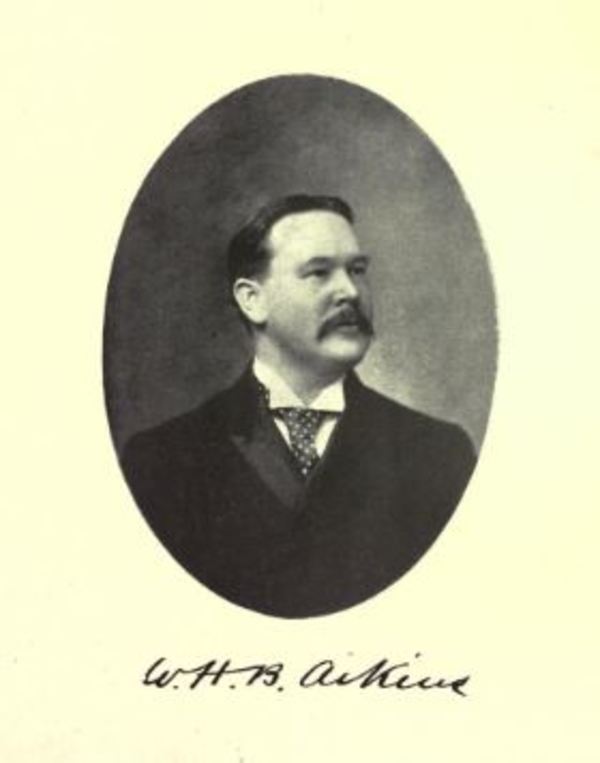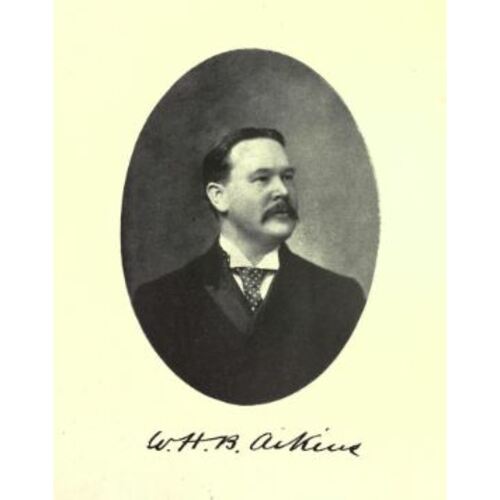
Source: Link
AIKINS, WILLIAM HENRY BEAUFORT, physician, medical editor, and founder of radiotherapy in Canada; b. 22 Aug. 1859 in Toronto Gore Township, Upper Canada, son of James Cox Aikins* and Mary Elizabeth Jane Somerset; m. 27 Dec. 1887 Augusta Hawkesworth-Wood in London, Ont.; they had no children; d. 2 Oct. 1924 in Toronto.
W. H. B. Aikins’s family was prominent in Canadian politics and medicine. His father, James Cox Aikins, served as secretary of state under Sir John A. Macdonald* and in 1882 became lieutenant governor of Manitoba (a post later filled by another son, Sir James Albert Manning Aikins). Two uncles, Moses Henry and William Thomas*, were well-known physicians.
Aikins received his early education at Upper Canada College in Toronto, the Toronto School of Medicine (mb 1881), and Victoria College in Cobourg (md, cm 1881). Like many physicians of his day, he pursued postgraduate studies in Europe, where he was exposed to the many pathological and surgical advances of the period. During this time he visited London (where he obtained his licentiate from the Royal College of Physicians in 1881), Edinburgh, Paris, and Vienna. In 1883 he established a general practice in Toronto, and he became prominent in Canadian medical circles. He was appointed to the staff at Toronto General Hospital, the Toronto Home (later Hospital) for Incurables, and Grace Hospital. On the editorial staff of the Canadian Practitioner from 1884 and co-editor of the Dominion Medical Monthly when it began in 1893, he became in 1895 the founding editor of the Canadian Medical Review; this journal merged with the Canadian Practitioner four years later to form the Canadian Practitioner and Review, with which Aikins would be associated until his death. In 1907 he was one of the charter members of the Academy of Medicine in Toronto, and in the years before World War I he represented Canada at several international medical congresses. In his private life he was a Methodist, a mason, and a senator of the University of Toronto.
Aikins’s major contribution to Canadian medicine was the introduction and promotion of radium therapy. Radium had been discovered by Marie and Pierre Curie in 1898, but it was not until Henri Becquerel inadvertently inflicted a skin burn on himself in 1901 that the effect of its radiation on living tissue began to attract medical interest. Over the next decade radium was found to be an effective therapy for many diseases, particularly cancer where it held hope for treatment without the need for the mutilating operations then in vogue. Because of the limited sources of radium-bearing ore and the huge cost of refining it, however, radium remained scarce and expensive.
In 1907 Aikins visited the Laboratoire Biologique du Radium in Paris, a centre for the study of radium, and was impressed by the element’s effects on various benign and malignant skin conditions. Like other doctors of the day, he marvelled at radium’s ability to produce changes in tissues which could not be achieved by any other known substance and which resulted in “cures of a very surprising character.” He returned from Paris convinced of its usefulness as a therapeutic agent. After visiting the Paris laboratory on two further occasions, he bought a small supply of radium in 1909, and soon opened a radium clinic, the Radium Institute of Toronto, at 134 Bloor Street West. Although small quantities of radium existed in other parts of Canada – it would not be refined here until the 1930s – Aikins’s institute became the primary centre for radiotherapy. His many published case reports show that he treated over 3,000 patients referred from a wide area extending from Saskatchewan to Quebec. His equipment in 1914 included a radium plaque (a flat applicator coated with a varnish impregnated with radium) and a tube containing radium salts. With these instruments he treated patients suffering from a variety of cancerous and non-cancerous conditions. He became intrigued by the microscopic tissue changes which underlay the clinical effects of radium and carried out investigations into them with Dr Keith Myrie Benoit Simon, pathologist at Grace Hospital.
Aikins became particularly interested in the use of radiotherapy in thyroid disease. In 1920 he reported on 16 patients with “toxic goiter” (hyperthyroidism) who had been treated with a regime of quinine, ergotamine, and the application of ice-bags over the heart and radium over the thyroid. It is easy now to be shocked or amused by Aikins’s use of radium to remedy benign conditions; at the time, however, there were no other effective treatments and there was limited awareness of the possible dangers of radiation. Patients and physicians alike were eager to try a new remedy for distressful or disfiguring diseases. To those who questioned the value of radium, Aikins replied, “I have several hundred living reasons on which my faith is founded, and they are walking about on two legs.”
His continuing role as a medical editor gave him the opportunity to publicize the effects of radium in numerous articles. He became a leading proponent of the new medical science of radiotherapy and presented frequent papers and lectures to the Academy of Medicine, the Ontario Medical Association, and the Canadian Medical Association. His topics included the use of radium in gynaecological disorders, skin conditions, tuberculosis, and leukaemias. In October 1916 a group of North American physicians met in Philadelphia to establish the American Radium Society. It is a tribute to Aikins’s reputation among his peers that he was unanimously elected its first president. As head of the premier North American organization for radiotherapy, he was in a unique position to synthesize the existing body of evidence about radium’s efficacy in medicine. This he did masterfully in 1919 in an address before the society entitled “The value of radium in curing disease, in prolonging life, and in alleviating distressing symptoms.” The three goals mentioned remain the primary goals of cancer treatment. Although he used radium to cure cancers, he was also interested in the purely palliative effects of radiotherapy. He felt that its greatest benefit was the relief it gave to “countless patients whose condition is absolutely hopeless from the point of view of cure.” His case reports note numerous examples of its successful use in treating pain, bleeding, or discharge from advanced, incurable cancers to provide comfort to dying patients.
By the time of his sudden death from heart disease the avuncular Aikins was a respected and much liked figure in Canadian medicine. Although he made no original contributions to radiation science, he demonstrated radium’s clinical effectiveness to Canadian doctors and eloquently articulated the role of radiation in medicine. He was a model of the clinician-experimenter who tested a new medical treatment empirically in the clinic rather than in the laboratory. His pioneering work stimulated Canadian interest in radium that led to such initiatives as the opening, under Joseph-Ernest Gendreau*, of the Institut du Radium in Montreal in 1923 and the various provincial cancer control programs of the 1930s. In his will Aikins left his medical books to the Academy of Medicine; his estate, worth over $90,000, included $9,950 in radium, described as his “stock in trade.”
William Henry Beaufort Aikins’s papers on radium and radiotherapy include “Radium as a therapeutic agent,” Canadian Practitioner and Rev. (Toronto), 32 (1907): 426–27; “Radium and its action in connection with certain diseases of the skin,” Canadian Practitioner and Rev., 34 (1909): 739–46; two reports co-written with F. C. Harrison, “Recent observations on the therapeutic use of radium” and “The present status of radium therapy,” Canadian Practitioner and Rev., 36 (1911): 1–10 and 465–79; an article co-written with K. M. B. Simon, “The histological and clinical changes induced by radium in carcinoma and sarcoma,” Dominion Medical Monthly (Toronto), 43 (July–December 1914): 97–107; “Personal experiences with radium,” Canadian Practitioner and Rev., 39 (1914): 535–45; “President’s address, Academy of Medicine, Toronto: the medical profession and the war; the cancer problem,” Canadian Practitioner and Rev., 40 (1915): 533–43; “The established value of radium as a therapeutic agent,” Canada Lancet (Toronto), 50 (1917): 494–505; “The value of radium in curing disease, in prolonging life, and in alleviating distressing symptoms,” Canadian Practitioner and Rev., 44 (1919): 229–37 (also published in the American Journal of Roentgenology (New York), new ser., 6 (1919): 439–44); and “Radium in toxic goitre,” Canadian Practitioner and Rev., 45 (1920): 339–50.
AO, RG 22-305, no.51299; RG 80-5-150, no.7744. UTA, A1973-0026/3(46). London Advertiser (London, Ont.), 28 Dec. 1887. Canadian Medical Assoc., Journal (Toronto), new ser., 14 (1924): 1132. Canadienne [A. R. Gale Hunt], “Radium as a remedy,” Saturday Night, 17 Jan. 1914: 29. J. T. Case, “The early history of radium therapy and the American Radium Society,” American Journal of Roentgenology (Springfield, Ill.), new ser., 82 (July–December 1959): 574–85. Commemorative biographical record of the county of York . . . (Toronto, 1907). C. R. R. Hayter, “William H. B. Aikins: forgotten pioneer of Canadian radiotherapy,” Royal College of Physicians and Surgeons of Canada, Annals (Ottawa), 31 (1998): 155–58. Douglas Quick, “William Henry Beaufort Aikins, m.d., c.m., l.r.c.p. (Lond.), f.a.c.p., 1859–1924,” American Journal of Roentgenology (New York), new ser., 12 (July–December 1924): 490. Standard dict. of Canadian biog. (Roberts and Tunnell).
Cite This Article
Charles Hayter, “AIKINS, WILLIAM HENRY BEAUFORT,” in Dictionary of Canadian Biography, vol. 15, University of Toronto/Université Laval, 2003–, accessed January 23, 2025, https://www.biographi.ca/en/bio/aikins_william_henry_beaufort_15E.html.
The citation above shows the format for footnotes and endnotes according to the Chicago manual of style (16th edition). Information to be used in other citation formats:
| Permalink: | https://www.biographi.ca/en/bio/aikins_william_henry_beaufort_15E.html |
| Author of Article: | Charles Hayter |
| Title of Article: | AIKINS, WILLIAM HENRY BEAUFORT |
| Publication Name: | Dictionary of Canadian Biography, vol. 15 |
| Publisher: | University of Toronto/Université Laval |
| Year of revision: | 2005 |
| Access Date: | January 23, 2025 |



